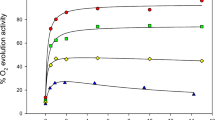Summary
Light and heavy sarcoplasmic reticulum vesicles (LSR, HSR) isolated from rabbit leg muscle have been used in a study of chloride-induced Ca2+ release. The biochemical and morphological data indicate that LSR is derived from the longitudinal reticulum and HSR is derived from the terminal cisternae of the sarcoplasmic reticulum. LSR and HSR were both able to accumulate Ca2+ in the presence of ATP to amounts greater than 100 nmol Ca2+/mg of protein in less than 1 min. LSR and HSR each had a biphasic time course of Ca2+ uptake. The initial uptake was followed by a rapid release, after approximately 1 min, of 30–40% of the accumulated Ca2+, which was then followed by a slower phase of Ca2+ accumulation. Ca2+ taken up by the SR vesicles could be released from both the LSR and HSR by changing the anion outside the vesicles from methanesulfonate to chloride. Due to the difference in permeability between methanesulfonate and chloride, this change should result in a decreased positivity inside the vesicles with respect to the exterior. It could also result in osmotic swelling of the vesicles. Changing the ionic medium from chloride to methanesulfonate caused no release of Ca2+. The amount of accumulated Ca2+ released in 6 sec by changing the anion outside the vesicles from methanesulfonate to chloride was 30–35 nmol/mg membrane protein for LSR and HSR, respectively. Osmotic buffering with 200mm sucrose caused a slight inhibition of chloride-induced Ca2+ release from HSR (17%→15%) but it greatly reduced the release of Ca2+ from LSR (32%→15%). The specificity of Ca2+ release was measured using SR vesicles which were passively loaded with 10mm 22Na+. LSR released five times more22Na+ than HSR under same conditions as chloride-induced Ca2+ release occurred. Na dantrolene (20 μm) had no effect on the release of Ca2+ from LSR but it inhibited the chloride-induced Ca2+ release from HSR by more than 50%. Na dantrolene also increased the Ca2+ uptake in the HSR by 20% while not affecting LSR Ca2+ uptake. Our results indicate the presence of a chloride-induced, Na dantrolene inhibited, Ca2+ release from HSR, which is not due to osmotic swelling.
Similar content being viewed by others
References
Baylor, S.M., Oetliker, H. 1975. Birefringence experiments on isolated skeletal muscle fibres suggest a possible signal from the sarcoplasmic reticulum.Nature (London) 253:97
Bezanilla, F., Horowicz, P. 1975. Fluorescence intensity changes associated with contractile activation in frog muscle stained with Nile Blue A.J. Physiol. (London) 246:709
Campbell, K.P., Shamoo, A.E. 1977. Depolarization induced calcium release from light and heavy sarcoplasmic reticulum vesicles.Biophysical J. 17:200a
Constantin, L.L., Taylor, S.R. 1973. Graded activation in frog muscle fibres.J. Gen. Physiol. 61:424
Desmedt, J.E., Hainaut, K. 1977. Inhibition of the intracellular release of calcium by Dantrolene in barnacle giant muscle fibres.J. Physiol. (London) 265:565
Ebashi, S., Endo, M. 1968. Calcium ions and muscle contraction.Prog. Biophys. Mol. Biol. 18:123
Endo, M. 1977. Calcium release from the sarcoplasmic reticulum.Physiol. Rev. 57:1.71
Endo, M., Blinks, J.R. 1973. Inconstant association of aequorin luninescence with tension during calcium release in skinned muscle fibres.Nature (London) New Biol. 246:218
Endo, M., Kitazawa, T. 1976. The effect of ATP on the calcium release mechanisms in the sarcoplasmic reticulum of skinned skeletal muscle.Proc. Jpn. Acad. 52:595
Fabiato, A., Fabiato, F. 1977. Variations of the membrane potential of the sarcoplasmic reticulum of skinned cells from cardiac and skeletal muscle detected with a potential-sensitive dye.J. Gen. Physiol. 70:6a
Franzini-Armstrong, C. 1975. Membrane particles and transmission at the triad.Fed. Proc. 34:1382
Fuchs, F. 1974. Striated Muscle.A. Rev. Physiol. 36:461
Hodgkin, A.L., Horowicz, P. 1960. The effect of nitrate and other anions on the mechanical response of single muscle fibres.J. Physiol. (london) 153:404
Inesi, G., Malan, N. 1976. Mechanisms of calcium release in sarcoplasmic reticulum.Life Sci. 18:773
Kasai, M., Miyamoto, H. 1976a. Depolarization-induced calcium release from sarcoplasmic reticulum fragments. I. Release of calcium taken up upon using ATP.J. Biochem. (Tokyo)79:5.1053
Kasai, M., Miyamoto, H. 1976b. Depolarization-induced calcium release from sarcoplasmic reticulum fragments. II. Release of calcium incorporated without ATP.J. Biochem. (Tokyo) 79:5.1067
Kometani, T., Kasai, M. 1978. Ionic permeability of sarcoplasmic reticulum vesicles measured by light scattering method.J. Membrane Biol. 41:295
Lowry, O.H., Rosebrough, N.J., Farr, A.L., Randall, R.J. 1951. Protein measurement with the folin phenol reagent.J. Biol. Chem. 193:265
Martonosi, A., Ferreros, R. 1964. Sarcoplasmic reticulum I. The uptake of Ca2+ by sarcoplasmic reticulum fragment.J. Biol. Chem. 239:648
Meissner, G. 1975. Isolation and characterization of two types of sarcoplasmic reticulum vesicles.Biochim. Biophys. Acta 389:51
Meissner, G., Fleischer, S. 1971. Characterization of sarcoplasmic reticulum from skeletal muscle.Biochim. Biophys. Acta 241:356
Meissner, G., McKinley, D. 1976. Permeability of sarcoplasmic reticulum membrane. The effect of changed ionic environments on Ca2+ release.J. Memrane Biol. 30:1.79
Nakajima, Y., Endo, M. 1973. Release of calcium induced by depolarization of the sarcoplasmic reticulum membrane.Nature New Biol. 246:216
Sandow, A. 1970. Skeletal Muscle.A Rev. 17:87
Somlyo, A.V., Shuman, H., Somlyo, A.P. 1977. Composition of sarcoplasmic reticulumin situ by electron probe X-ray microanalysis.Nature (London) 268:566
Stephenson, E.W., Poldolsky, R.J. 1977. Influence of magnesium on chloride-induced calcium release in skinned muscle fibers.J. Gen. Physiol. 69:17
Thorens, S., Endo, M. 1975. Calcium-induced calcium release and depolarization-induced calcium release: Their physiological significance.Proc. Jpn. Acad. 51:473
Zimniak, P., Racker, E. 1978. Electrogenicity of Ca2+ transport catalyzed by the Ca2+ ATPase from sarcoplasmic reticulum.J. Biol. Chem. 253:4631
Author information
Authors and Affiliations
Rights and permissions
About this article
Cite this article
Campbell, K.P., Shamoo, A.E. Chloride-induced release of actively loaded calcium from light and heavy sarcoplasmic reticulum vesicles. J. Membrain Biol. 54, 73–80 (1980). https://doi.org/10.1007/BF01875378
Received:
Revised:
Issue Date:
DOI: https://doi.org/10.1007/BF01875378




